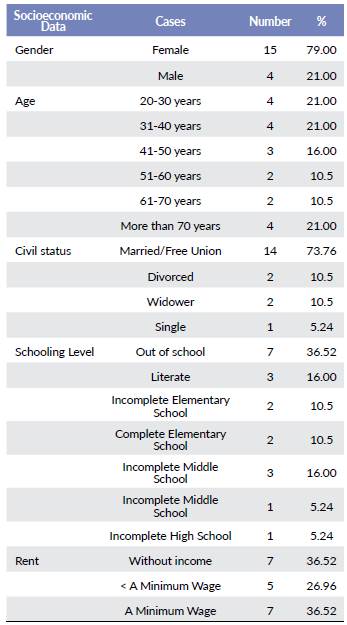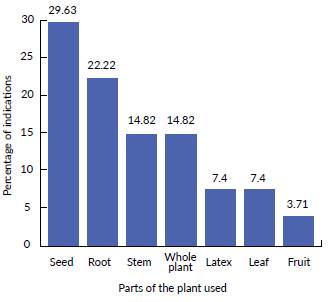INTRODUCTION
The Euphorbiaceae is vastly diverse and widely distributed throughout the world, mainly in the tropics and temperate regions (Barroso 1991, Webster 1994). In Brazil, the family is represented by 63 genera, 940 species, 35 subspecies, and 33 varieties (Cordeiro et al. c2015). In general, the species of this family are considered important because of their use and economic potential for human food and medicine, practices derived mainly from the traditional knowledge of local populations (Trindade and Lamera 2014). The prevalence of the Euphorbiaceae family is also highlighted by ethnobotanical studies developed in the Brazilian Semiarid Region (Cartaxo et al. 2010, Pereira Júnior et al. 2014, Silva et al. 2015a). Historically this region has been poorly studied, despite the biocultural richness associated with its biodiversity (Albuquerque et al. 2007).
Local biocultural diversity can be comprehended through ethnobotany (Albuquerque et al. 2017), which can be understood as the study of the interrelations between cultures of human groups and the plants of their surrounding area. Ethnobotany can also include environmental and cultural factors, as well as the definition of plants by cultures (Albuquerque 2005). In recent years, ethnobotany has gained worldwide prominence and has a position of relevance in the conservation of local knowledge, having a particularly important role to play in the rescue of Local Biocultural Memory (LBM) (Siqueira et al. 2017, Bussmann 2019).
Several studies conducted on a global scale demonstrate the importance of ethnobotanical research on a botanical family (Awan and Murtaza 2013, Silva et al. 2014a, Chaves and Barros 2015, Amiri and Joharchi 2016, Castañeda et al. 2017, Dewangan and Acharya 2017), and many of these are related to the Euphorbiaceae family (Kumar 2012, Beg 2015, Crepaldi et al. 2016, Sinhababu and Banerjee 2016). However, these are general studies that do not focus specifically on botanical families in rural home gardens or agroforestry systems, which are also of great biocultural importance.
Based on that identified knowledge gap, we propose that it is necessary to identify and rescue the traditional knowledge surrounding the ethnobotany of the Euphorbiaceae family in rural home gardens. The registration of local knowledge is essential to conservation, particularly considering that important information and traditional knowledge surrounding the use of plants can face the threat of disappearance (Cajaiba et al. 2016). The process of acculturation begins as soon as new generations seek modern means of communication, potentially leading to the loss of this vital relationship between humans and plants, which is traditionally transmitted orally in these communities (Pilla et al. 2006).
It should be noted that when we discuss biocultural behavior and/or biocultural attitudes, we are referring to the interrelationships that are established between biological and cultural elements in the human species; interactions that determine biocultural behaviors (see Siqueira 2018). In this context, "culture acts as a learned and shared behavior, essential to our species since human behaviors is derivedfrom culture and based on biology" (Sutton and Anderson 2010). Interesting discussions are presented by Richerson and Boyd (2005) on the topic human behavior, in which they argue that not only genes determine behavior in our species, but that culture is a strong determinant as well.
The objective of this study was to document the biocultural practices and/or biocultural behavior associated with the use of species of Euphorbiaceae family in home gardens in a rural community located in the Semiarid Region of Piauí State, Northeastern Brazil. Taking an ethnobotanical approach, we decided to focus our research on the Eu-phorbiaceae family because of its wide distribution across Brazilian territory, as well as its biocultural importance for several rural communities of Northeastern Brazil. We aimed to gain a greater understanding of the human behavior associated with the uses of species of the mentioned botanical family.
MATERIALS AND METHODS
Study area
Fieldwork and/or data collection were carried out in the Franco rural community (Fig. 1), Municipality of Cocal (03°28'15" South - 41°33'18" West), Piauí State (Northeastern Brazil), 268 km from the capital, Teresina. Cocal has a population of 26.036 inhabitants with a population density of 20.51 inhabitants/km2 (IBGE c2010).
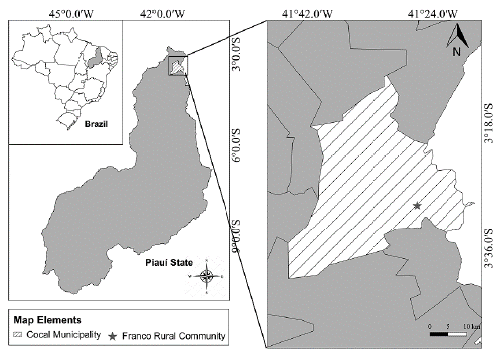
Figure 1 Location of the Franco ruralcommunity, CocalMunicipality, Piauí State, Northeastern Brazil.
According to the classification of Köppen, the community area falls under the domain of climates Aw' - Tropical, characterized by two seasons: a rainy summer and a dry winter. Temperatures fluctuate between 25 °C and 35 °C. The annual average of rainfall is 900 mm and is characterized by greater rainfall from March to May, with a surplus up to 436 mm. It is lower between July and December when it is possible to register a deficit of 728.0 mm (Medeiros 2004).
The local vegetation is described as Carrasco, a non-thorny deciduous vegetation (Chaves and Barros 2012), with transitions between hyperxerophilic Caatinga, a thorn deciduous vegetation, and/or Cerrado, a tropical savanna vegetation (Jacomine 1986). Most of the community is rural; the inhabitants are mainly farmers, and some of them practice hunting sporadically (Siqueira et al. 2017).
Ethical procedures and data collection
The present study was evaluated and approved (Protocol N° 1.408.907) by the Committee for Ethics in Research (CER) at the Federal University of Piauí (UFPI), Campus Ministro Reis Velloso (CMRV), following the Resolution 466/2012 of the National Council of Health (CNS, acronym in Portuguese) (Brasil 2012).
To collect the socioeconomic and ethnobotanical data for this study, several visits to the community were carried out between October 2015 and October 2017. According to Vogl et al. (2004), sampling in home gardens should depend on the objectives and circumstances of the research. In this ethnobotanical study, based on the delimitation, an informant was selected from each residence, age 18 or older. These individuals were primarily responsible for the care and maintenance of the home garden in their household. Interviews were conducted only with those who had active home gardens (Florentino et al. 2007), obtaining plants of the Euphorbiaceae family.
Informal and formal conversations, discussions, and interviews were carried out through semi-structured forms, as well as field visits (Martin 1995). Each informant was read the terms of Free and Informed Consent, and their signature was requested after they had given affirmative consent to participate in the investigation in the presence of two witnesses. Photographs were also registered, respecting the consent given by signature on the document "Term of Image's Use", under Resolution number 510 of April 07, 2016 of the CNS (Brasil 2016).
The indicated species were collected from the informants' home gardens. Regarding the registration of the species, the collection and processing of botanical material were carried out according to the methodology outlined by Santos et al. (2014). Botanical identification of the species was accomplished by morphology study and consultations to specialized literature. The samples were compared with individual plants already identified in the herbarium and/ or sent to specialists (Silva et al. 2014b). Specimens of the botanical material were then deposited in the collection of the "Delta do Parnaíba" Herbarium ("HDelta"- UFPI/ CMRV). The botanical synonymies were updated with reference to a database available in the List of Flora Species of Brazil (REFLORA c2017), in order to determine the origin status of the species. The information referring to the habit of the species was determined on Font Quer (1977). The classification of the species has been in accordance with the proposal developed by Angiosperm Phylogeny Group IV (APG IV 2016).
Analysis of data
The citations of uses were grouped into various ethnocat-egories (Cárdenas et al. 2002), with the addition of the categories "toy, fence or hedge and saponiferous". In this case, the ethnocategories of use correspond to the general uses that people give to plants (David 2015). The Use Value (UV) was calculated for each indicated species of the Euphorbiaceae family, according to the proposal developed by Phillips and Gentry (1993), and using the formula:
Where: U = the number of citations (or uses) by ethnospe-cies, n = the number of informants that cited the ethnos-pecies (a folk classification, synonymous with the common or vernacular name, see Medeiros et al. 2016) or species.
Multivariate linear regression analyses were also used to examine whether socioeconomic factors such as gender, age, schooling, and monthly income, could help to explain the number of known species and the number of indications for the botanical family studied. The statistical tests were performed using the BioEstat 5.0 Software (Ayeres et al. 2007), where P < 0.05 was considered to indicate the statistical difference.
RESULTS AND DISCUSSION
General profile of the informants and socio-economic aspects
19 informants were interviewed, of whom 79 % were female (n = 15) and 21 % male (n = 4). This means that, of the sample group, 15 women were responsible for home gardens care, while men maintained four home gardens.
Thus, it was verified that women play a key role in the management of species of the Euphorbiaceae family in rural home gardens of this community. This may partly be the result of the difference between local functions performed by men and women. In general, women tend to take care of the home gardens area, while men are dedicated to collecting firewood/plants in the woods, fishing, and hunting. In general terms, men tend to be more in touch with the environment far away from their homes. Similar information about the predominance of the female gender in the maintenance of biocultural values in home gardens has been reported in the Piauí State (Aguiar and Barros 2012, Pereira et al. 2016, Silva et al. 2017). Despite this, it is essential to mention that the male figure plays a critical biocultural role in the use and management of vegetal species in rural home gardens (Martins et al. 2017).
Most of the informants were found to have low levels of schooling (Table 1) and few financial resources. Their incomes tended to be obtained from subsistence agriculture and the trade of some products from the home gardens. Some of the men also reported that they hunted at certain times of the year to supplement the family's protein diet.
Local botanical knowledge
Seven species (Table 2) of Euphorbiaceae presented in the rural home gardens were cited, these were distributed across four genera, most notably the genus Jatropha (3 spp.) followed by Manihot (2 spp.). Concerning the habit of the species, shrubs were predominant (Fig. 2). In this context, the habit of species seems to play a crucial role in their cultivation and maintenance in home gardens, since smaller species are preferred for cultivation/use in these spaces in different geographical areas (Martins et al. 2017, Silva et al. 2017, Sousa et al. 2018). In addition, there is the fact that the concept of home gardens involves the cultivation of species near homes (Huai and Hamilton 2009), inferring that smaller species are relatively easy to grow and care of around or near homes, often adopted for access to the species.
Table 2 Diversity of species of the Euphorbiaceae family cultivated in home gardens in the Franco rural community, Cocal, Piauí State, Brazil.

H- Habit; Shr- Shrub; Tre- Tree; O- Origin; N- Native; E- Exotic; S- Naturalized; UC- Use Category or Ethnocategory; UV- Use Value.
Regarding the origins of the species sampled, the native species were found to be most prevalent (71.42 %) (Fig. 2). In this context, Croton blanchetianus Baill. ("marmeleiro") was the only species of Euphorbiaceae that was found growing spontaneously in the inventoried home gardens. The other species identified were produced as a result of the exchange of seedlings and/or seeds among the local inhabitants who had grown plants in their own home gardens, areas of biocultural importance. In this way, the home gardens are highlighted as valuable conservation spaces for native species (Florentino et al. 2007).
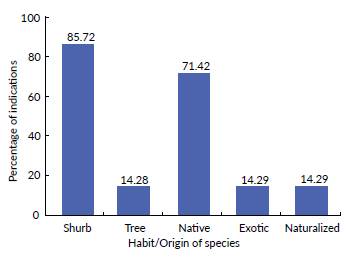
Figure 2 Habit and status of origin of the species of the Euphorbiaceae family cultivated in the home gardens of the rural Franco community, Cocal, Piauí State, Brazil.
There were a total of 170 indications of use (indications regarding the way the species are used) for species of Euphorbiaceae grown in the home gardens of the Franco community. The ethnocategory that stood out the most was food (35.30 %), followed by medicine (16.48 %) (Fig. 3). In Brazil, the Euphorbiaceae is used mainly as food and for medicinal purposes (Trindade and Lameira 2014); therefore, our findings converged with the general data reported for the botanical family across the broader Brazilian territory. In general, the purpose of home gardens in the areas is related to the provision of foods and phytotherapeutics, priority needs of humans (Gbedomon et al. 2017).
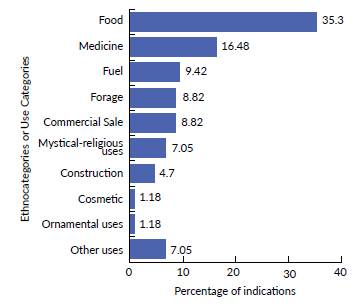
Figure 3 Frequency of the ethnocategories of uses reported for cultivated species of Euphorbiaceae in the Franco rural community, Cocal Municipality, Piauí State, Brazil.
In terms of the parts of the plant most commonly used, the seed stood out (29.63 % of the total indications) (Fig. 4). Regarding the preparation method of the home remedies, oil was the most significant (42.86 %), followed by infusion (28.57 %) and poultice (28.57 %). This profile highlights the great biocultural importance of oil locally in the Franco rural community. This prominence of this method of extraction and use could be said due to the broad traditional knowledge related to "mamona" (R. communis) among the participants, an ethnoespecies of great local versatility. The fact that the seed is the most commonly used part of the plant is associated with the biocultural heritage manifested among the inhabitants on that reproductive structure to the extent that it allows the extraction of the "mamona" oil and its use for different purposes in different contexts and needs.
Description of the biocultural behavior and traditional practices associated to the species cultivated in the rural home gardens in the Franco community
Ricinus communis L.
This species is known by the common name of "mamona", and was presented as having many diverse uses among the informants, classified within several ethnocategories. It is the ethnospecies of the Euphorbiaceae family grown in the home gardens with the highest biocultural importance, presenting UV = 7.0. The main product is oil, extracted from the seeds. However, the fruits in their green state can be used for other purposes: as a toy by the children, for example, who often throw the fruits to each other, simulating a war.
In order to extract the oil, the seeds of R. communis are processed in stages: cleaning (Fig. 5a), washing (Fig. 5b-c), drying (Fig. 5e), toasting (Fig. 5f), maceration (Fig 5g), boiling (Fig 5I1), concentrating of oil (Fig. 5i-j), filtration (Fig. 5k-1), cooling (Fig. 5m-n) and potting (Fig. 5o-p). After the is extracted, it is used for several purposes. In terms of its medicinal uses, there are several applications in the community with the intention to cure human illnesses such as flu and pneumonia.
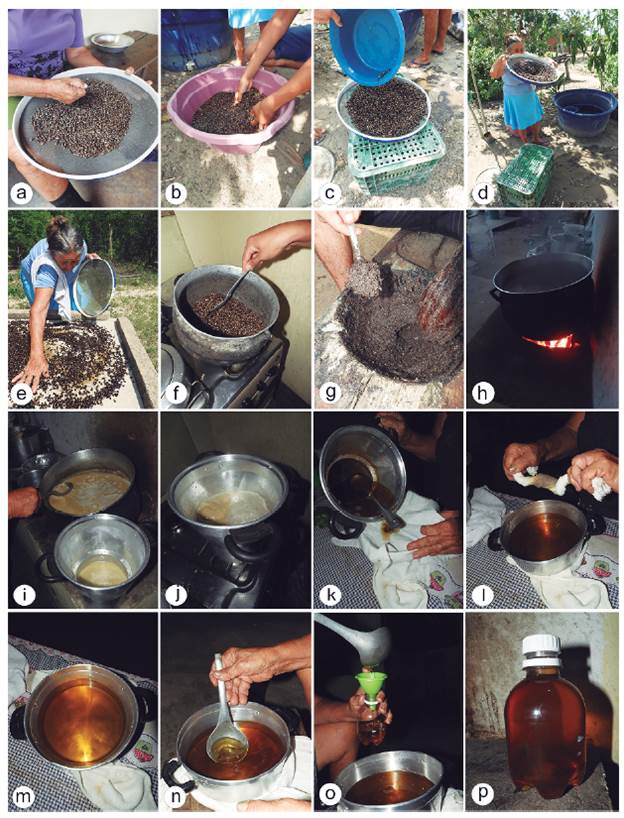
Figure 5 Extraction stages of oil "mamona": a. Manual seed cleaning; b. Washing; c-d. Sifting; e; Drying; f. Toasting; g. Maceration; h. Boiling; i-j. Concentrating of oil; k-l. Filtering; m-n. Cooling; o. Container; p. Final oil "mamona" resulting from extraction in the Franco rural community. Photos: Siqueira, J.I.A. (2018).
In the treatment of flu or pnemonia, for example, a tablespoon of the oil and two of honey are mixed and a spoonful of the mixture should be taken once a day, over a period of three days. This traditional knowledge about the use of "mamona" oil to treat influenza is not restricted to the Franco rural community. In other regions of Piauí State, this oil is also reported to treat influenza in different cultural contexts (see Almeida Neto et al. 2015, Silva et al. 2015b). In spite of this ethnobotanical convergence in some points, variations in the dosage and additives to the home remedy are registered.
Another application indicated by the informants is the treatment of children who have short stature for their age (locally called "entanguidos"). One tablespoon of oil should be mixed with two tablespoons of honey; two or three doses of the mixture are administered orally once a day. The informants reported that only children from two years of age can receive the mixture, with the help of a coffee spoon, which must be smaller than the soup spoon. They also emphasize that the dose for children should be smaller than the dosage for adults.
There seems to be a consensus in ethnobotanical studies regarding the importance of dosing differences in preparations of home remedies for children and adults, despite geographic and cultural isolation. Teklehaymanot and Giday (2007), developed an ethnobotanical study on medicinal plants in the Zegie Peninsula, Northeast of Ethiopia. These authors reported the importance of dosing, documenting that children should receive a lower dose than adults. They also discussed the relationship between the variation of the portion according to the type of disease as well as its severity, converging with the data obtained from Franco rural community.
A mixture of "mamona" oil with honey, according to the response of some interviewees in Franco rural community, is also used for general inflammation and stomach pains, including diarrhea. One spoonful should be taken once a day as soon as the problem begins. In addition, it is given to children and/or adults who have a natural inability to increase their body mass. It is thought to it improve the functioning of the digestive system and the absorption of nutrients. Furthermore, the ingestion of the oil also serves to cleanse the skin. The same mixture described previously is used. According to the interviewees, the oil has properties that allow cleaning the skin, removing stains and blemishes resulting from sun exposures. Moreover, the oil is used as a moisturizer for hair, mainly to prevent hair loss.
There are several discussions about the toxicity of this species. The seeds of R. communis contain a natural tox-albumin called ricin, which is considered highly toxic (Alexander et al. 2008). Fonseca and Soto-Blanco (2014), also highlight the toxic potential of this glycoprotein, mentioning its possible use as an agent of war or bioterrorism. It is important to note that the processed oil itself is not toxic since ricin, the toxic protein, is largely removed during the extraction process (Maia et al. 2010). The inhabitants of the Franco rural community know the danger that the species represents, mainly for children and domestic animals.
However, there is consensus that the oil extraction stages remove this toxic compound, which was previously present.
Regarding the toxicity of ingested "mamona" oil, the use of water during the boiling stage of preparation (Fig. 5h) was identified to be of crucial importance. This stage is indispensable for removing the ricin because the protein is soluble in water (Fonseca and Soto-Blanco 2014).
Despite the great importance of the species as expressed by local informants, there is concern among the community about the conservation of the Local Biocultural Memory (LBM) related to the biocultural practices surrounding R. communis. Although the species is invasive in twelve phytophysiognomies occurring in Brazil (Zenni and Ziller 2011), in the Franco community this "alien" phenomenon is not registered, and few individuals plants are observed growing spontaneously (outside the cultivated areas) generally near to the residence and far from the forest. In the past, the seeds of this species could be purchased at the Free Fair of Cocal city. Over time, however, the old seed sellers have become rare. Thus, the seeds have become challenging to find. An alternative solution to this problem is to cultivate the species from itself in order to conserve the plant, biocultural diversity and ensure its continuity.
This situation reveals the importance of care in the local cultural identity. It exists as an inseparable relationship between human and nature, in which the environment expresses an essential factor for social survival, source of life, and cultural identity (Cunha 1992). The potential loss of empirical knowledge also represents a breakdown and deterioration of local cultural traits and the elimination of adaptive behavior to the extent that culture is a human adaptation as mentioned by Mesoudi and Whiten (2008).
Another threat to LBM is based on the fact that the knowledge about "preparing" the dough from the seeds to extract the oil is not distributed homogeneously in the Franco rural community. The full process appeared to be known by only one or two informants. Furthermore, only one key informant who possesses such competence acknowledged the value of this traditional knowledge, affirming that oil preparation is not a simple task. Learning about these practices was the result of years of observation and practice with his mother, who had the concern to transfer that traditional knowledge. Aziz et al. (2018), comment that the erosion of empirical knowledge can occur at a high rate, due to several factors, such as accelerated modernization. In the Franco rural community, a range of factors works as a barrier to the maintenance of bioculturality associated with such traditional knowledge. Among these factors are the lack of interest by the younger generations and the prejudice towards this knowledge, often seen as false and/or invalid.
From this threat perspective, there is a consensus about the scarcity of people who can carry out the extraction of oil. It is clear that the relationship between the level of effort involved in the extraction of oil versus the price of the final product is not compensatory, since a small bottle of oil is sold for R$ 25.00 (around USD 7.00) in the Free Fair of Cocal city, being even commercialized to other rural communities belonging to the city and to other cities in the country, such as Brasília, São Paulo, Mato Grosso, Tere-sina, Parnaíba, Piracuruca, Cocal dos Alves and Fortaleza.
From a multidisciplinary and biocultural perspective, there is a network of contacts characterized by people distributed across several cities who indicate that in the Franco community, the extraction of "mamona" oil is carried out. The indication in the external-internal sense to the community is the result of the difficulty in finding someone who knows and performs this biocultural activity.
In this field of external valorization of community, the key informant takes great pride in the knowledge she possesses and has a genuine concern about the transmission of this knowledge to future generations. To ensure it is not lost, she teaches her daughters and granddaughters how to perform this task, which is influenced by the cycle of the moon. One recommendation for oil extraction is that it should be performed during the new moon because according to the interviewee, other lunar phases are not as productive in terms of the volume of oil extracted.
Biocultural practices like this involve a set of culturally essential symbols or codes. The accounts in ethnobotanical studies about beliefs, rituals, and customs that involve the influence of the moon related to the extraction of natural products native from the flora manifest a cultural character that varies from community to community. To illustrate, Costa (2013), documented a traditional practice surrounding the extraction of "copaiba" oil (Copaifera sp.) from the identity and ethnobotanical knowledge of the inhabitants of the National Forest of Amapá, Brazil. That author documents that after finding the tree in the forest, it is necessary for the practitioner to wait until the third night of the full moon and return later to the place. The trunk is perforated and he highlights the importance of not looking up to the sky. The hole is then closed with a stopper, and the practitioner returns 11 days later to collect the oil. The incorrect execution of the practice, according to the informants, can negatively influence the volume of extracted oil.
Manihot esculenta Crantz
The description of the cultural practices surrounding this species included two ethno-varieties differentiated locally by their toxicity: the "mandioca" (toxic plant) and the "macaxeira" (non-toxic plant), which present various uses, mainly food. The ethnoespecies obtained UV = 6.0, is the second species of Euphorbiaceae in the home gardens of greater biocultural importance. The root of the "mandioca" is used to prepare the flour and make a mass dough known as "goma", which can be used to produce several foods.
In addition, it is also possible to prepare a mass called "puba", which can be fresh or dried, used to prepare cakes and porridges. Dried husks obtained from the roots are used to feed animals such as goats (Capra aegagrus Erxleben, 1777) and cattle (Bos taurus Linnaeus, 1758). The stems of the species are used for vegetative propagation and also sold for this purpose.
The main product is "mandioca" flour, which is a significant product in the diet of the native populations of Brazil. Its use is of fundamental importance to the subsistence of these communities (Santos 2017), presenting not only nutritional and economic value but also manifesting a cultural significance in the Brazilian people's diet (Cascudo 2011). During the time of flour and/or other product preparation, meetings take place in specific places, known as "flour houses", where family members, friends, and inhabitants of the community and other nearby communities gather for that purpose. In these spaces, the sharing of knowledge and experiences is verified, which is part of the local culture.
The "mandioca" is a rich source of carbohydrates. According to Cock (1990), to every 1 kg of "mandioca" there are 1460 calories, 347 g of carbohydrates, 625 g of water, 12 g of protein, 3 g of fats, 330 mg of calcium, 7 mg of iron and the presence of amounts of some vitamins, playing an essential role in food security in rural communities (Salvador et al. 2014). The "macaxeira" (non-toxic), cooked roots are used as food, usually accompanied by coffee.
Croton blanchetianus Baiil.
Known by the common name of "marmeleiro", this species has specific medicinal uses, besides being used as fuel (firewood and in the production of coal) and for its wood. For medicinal purposes, a tea with the leaves is prepared as an infusion to treat belly inflammation. The property attributed to the plant to treat inflammations from the leaves may be related to the presence of flavonoids in the vegetative structures of the species (Aquino et al. 2017). Concerning its use as fuel, firewood is used directly to prepare food and/or to produce coal. Additionally, the wood of "marmeleiro" is mixed with the wood of other species to build fences. According to the Use Value, the species presented UV = 4.0, making it the third most important bioculturally among the species of the Euphorbiaceae.
Jatropha curcas L.
The species is known in the community by the popular name of "pinhaomanso". It is mainly used as a living fence. It can also be used to treat bleeding. In addition, latex has medicinal applications, such as the fight against fungi by the daily topical application of the liquid. The seeds are used to prepare robust and liquid soaps (detergent).
Additionally, the species has pharmacological, toxicological, biotechnological, and environmental importance (Santos et al. 2008). This species is therefore significant due to its use as a living fence in Brazilian Semiarid Region (Em-peraire and Pinton 1986), the efficacy in the treatment of skin problems (Lans 2007), and the procoagulant and anticoagulant action (Osoniyi and Onajobi 2003). As soap, it is considered effective due to the presence of saponins in the seeds (Makkar et al. 1998). The species received UV = 3.0.
Jatropha gossypiifolia L.
This species is known by the common name of "pinhao-roxo", having UV = 3.0. It has mystical-religious uses and as a living fence. Also, branches and leaves are used to bless children. During this practice, there is a belief that the spiritual forces of evil are transferred from the infant's body to the plant used and, according to the informants, this would be the reason for the wilting of the leaves during this empirical activity. Additionally, it is also used as a living fence, retaining the dust that would otherwise enter the houses.
It has been observed that in the Franco rural community, there is a female healer, a local specialist woman who uses the species in mystical-religious rituals involving infants and/or children. Due to the diffusion and knowledge about these practices, there is a demand for this specialist in the community, mainly by local people and other neighboring villages. Oliveira and Trovão (2009), mention a similar case when studying the use of plants in rituals of prayers and healers in the state of Paraíba, Northeastern Brazil, documenting the importance of these rituals considering the firm belief in ritual practice.
Jatropha multifida L.
There is not a common name for this species, which is used as ornamental, presenting UV = 1.0. It is cultivated in environments close to residences, mainly in front of houses or in their surrounding areas, playing an aesthetic role. Because of its toxicity, the species can represent a danger to children, who are attracted by the colors and shape of its fruits as well as its flowers. Its toxicity is due to the presence of the curcin, a toxic lectin (van Wyk et al. 2002).
The species is usually obtained through the exchange between friends from different communities, or even bought in the Free Fair of Cocal. It is worth noting that in different parts of the world several studies report that many ornamental plants do not have a common name in the communities studied (e.g., Mekonen et al. 2015, Pereira et al. 2016, Kebebew 2018), a phenomenon observed in the Franco rural community.
Manihot glaziovii Müll.Arg.
This species is known by the common name of "maniçoba", having UV = 1.0. According to the informants, the species is toxic but it is kept in the middle of essential crops in the community, mainly "mandioca", with the purpose to kill or weaken the animals that invade cultivation areas and therefore helping guarantee the integrity of the species cultivated for some purpose, mainly food. The species shows toxicity due to hydrocyanic acid and represents a danger to many animals such as goats (Amorim et al. 2005).
Use Value, linear regression analysis and social/cultural learning
The species that presented higher UVs were R. communis and M. esculenta (with values of 7.0 and 6.0, respectively), followed by C. blanchetianus (UV = 4), J. curcas and J. gossypiifolia (UV = 3, each), J. multifida and M. glaziovii (UV = 1, each). The data reflect the size and/or importance of the two species with higher UVs in the traditional local system, justified by the effect of the multiple uses and applications of the species for food, medicinal purposes, among other uses. Crepaldi et al. (20l6), also reported R. communis and M. esculenta, through another ethnobo-tanical index, as the most important species for the informants in the rural community of Horizonte, municipality of Jardim, Ceará State, Northeastern Brazil.
On multivariate linear regression analyses, the results highlight that the number of species used in the Euphor-biaceae family grown in the community is independent of socioeconomic factors such as gender, age, schooling, and monthly income, (R2 = 0.l85 and F = 0.545, P < 0.05). It was also found that the number of indications for use is independent of the socioeconomic factors evaluated (R2 = 0.l22 and F = 0.745).
In this context, the socioeconomic factors did not influence and/or determine the biocultural behavior related to the use of species of the Euphorbiaceae in the home gardens. It is suggested that this be a reflection of the need for these species in routine, associated with the dissemination of sociocultural practices in the community. Our findings suggest that when empirical knowledge is important bio-culturally, it tends to spread rapidly through the community and recognized among the local population.
The knowledge about such practices is given by vertical transmission, horizontal and oblique (Cavalli-Sforza and Feldman l98l, Hewlett and Cavalli-Sforza l986), whether in the middle of emergencies or not. Such relationship is explained by the socialization and family and/or extra-family coexistence within the community. Chaves and Barros (2015), state that empirical knowledge about a specific botanical family can be extended to both genders as a direct consequence of the observation of many empirical practices, which are usually carried out when many members of the family, from different age groups, are present contributing to the socialization of traditional knowledge.
FINAL CONSIDERATIONS
The participants of this research study are owners of important local botanical knowledge about the species (n = 7) cultivated from the Euphorbiaceae in the Franco rural community. These individuals manage the propagation of these species and utilize them for food, home remedies, cultural expression, fuel, commercial sale and many other purposes. The plants are firmly linked, therefore, to the local cultural identity. The knowledge about the biocultur al practices is distributed among the informants because of the rapid diffusion methods within the community. Some biocultural practices, however, were found to be concentrated among only a few informants, in general, the older ones. The species R. communis (UV = 7.0) and M. esculenta (UV = 6.0) were the most important and versatile as reported by the informants.
In addition, the execution of some sociocultural practices may involve a set of symbols, rituals and/or beliefs of a cultural nature associated with the local biocultural behavior. From a general perspective, using as a model the species of the Euphorbiaceae, the home gardens represent spaces of biocultural importance for the Franco rural community, essential for maintaining the biological and cultural conservation associated with the use of plants.
Added to this, the data provide a basis for the perspectives of rescuing of Biocultural Memory on the botanical family understudy amid of threats and vulnerability to some documented sociocultural practices. It is of great importance that new discussions are generated about the threats to traditional knowledge. Ethnobiologists, professionals with a theoretical and epistemological basis to identify threats to traditional knowledge can contribute to the protection and safety of empirical knowledge as components of local cultural identity.
The creation and application of public policies that act to protect and transmit Biocultural Diversity (Boege 2008, Maffi and Woodley 2010) and Biocultural Memory (Toledo and Barrera-Bassols 2008), is an urgent need, and according to the findings of this ethnobotanical research, a requirement. Further analysis of cultural traits and the generation of educational material surrounding this knowledge, is also essential, in order to generate educational programs that can initiate discussion and help transmit the importance of traditional knowledge and biocultural behavior in an educational environment.














